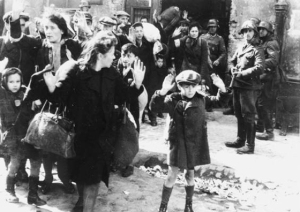
This famous photo is being used to illustrate a recent news article about the Jews killed in the Holocaust
I wrote about the photo above in this previous blog post: https://furtherglory.wordpress.com/2015/06/05/photo-of-the-little-boy-with-his-hands-up-the-rest-of-the-story/
The following quote is from a news article, which uses the photo above:
Begin quote
The soldiers in the First World War knew they might die and were encouraged to write letters to their loved ones, which were only delivered in the event of their death.
Such closure was denied the Jews, cruelly separated on arrival at Auschwitz and sent to the gas chambers thinking they were merely having a shower.
Thousands, like my grandfather Armin Klein, were picked up away from their loved ones with no opportunity to express their feelings or say goodbye – their families were left wondering what had happened.
I want people to understand what the Holocaust was really like and I hope I have achieved that. The ripples created by the Holocaust pebble in the world’s pond still undulate. They probably always will, while Yad Vashem receives 4,000 books on the Holocaust each year.
The betrayal of the Jews by the Nazis was so severe that a whole raft of international law came into force after 1945. However, the occurrence of the Holocaust does not mean that appropriate international law did not exist.
The pre-1945 international laws were perfectly adequate to protect everyone from the horrors of the Holocaust – the Nazis just chose to ignore them, as subsequent genocides have ignored the new legislation.
The Jews were told complete and deliberate lies about their future and destinations, what they could take with them, what would happen to them and their families.
End quote
But it gets worse. The article continues with the story of what happened at Treblinka:
Begin quote
Even at the very end, when they were told they were going for a shower – in Treblinka, the gas chambers were disguised as traditional Jewish bathhouses with roof tiles made by a manufacturer whose trademark was identical to the Star of David, apparently called a ‘Molette d’eperon’.
The forensic archaeologist who worked at Treblinka told me: “I did find multiple tiles like this at Treblinka, some still cemented to foundations.” The star is not actually the star of David, as it turns out, but rather an emblem of a Polish tile manufacturer. Without a doubt, though, the Nazis modelled the gas chamber on a Jewish bathhouse and these same tiles can be found in other Jewish bathhouses throughout Poland.
I consider the lies that were told to Jews throughout their persecution to be an overwhelming betrayal.
The failure to tell people they were about to be killed is unforgiveable because the Jews were entitled to know their lives were about to be ended so they could prepare themselves and, where possible, say their goodbyes.
End quote
It is hard to believe how cruel the Nazis were, not even allowing the Jews to write a final letter before they were killed. I wrote about Treblinka on my website at http://www.scrapbookpages.com/Poland/Treblinka/introduction.html


